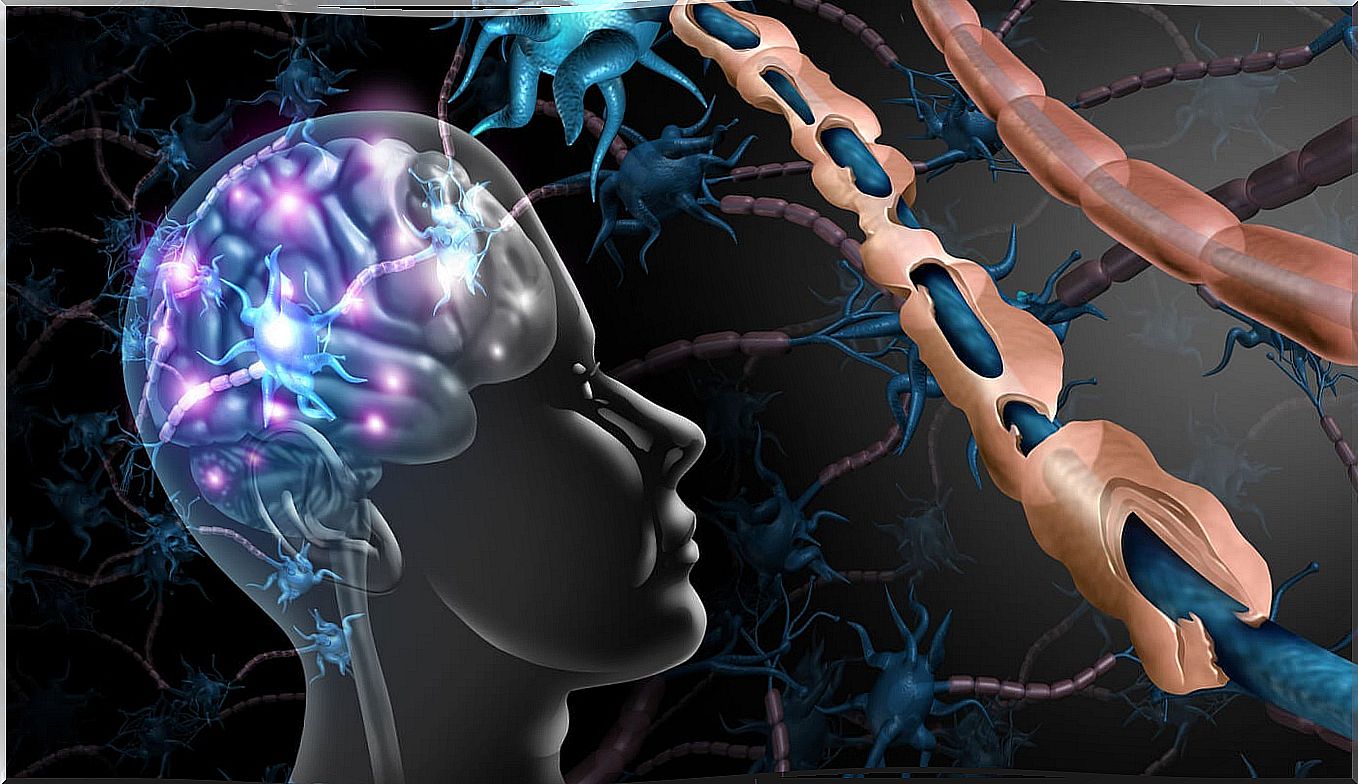Demyelination: Everything You Need To Know
Demyelination is a pathological process in which the myelin layer of nerve fibers is damaged; that is, the covering of neuronal axons. According to the Con la MS foundation, multiple sclerosis affects about 2.5 million people in the world, making it the most common demyelinating disease globally.
Even so, this is not the only pathology related to the destruction of the protective covering of the nerve fibers: optic neuritis, transverse myelitis or acute disseminated encephalomyelitis are some more examples of this type of disease. If you want to know more about the demyelination process, keep reading.
What are demyelinating diseases?

As an article published in the Offarm Magazine indicates, a demyelinating disease is any condition that causes damage to the protective layer (the myelin sheath) that surrounds the nerve fibers of the brain, the optic nerves and the spinal cord. This demyelination process can trigger the malfunction of various organs and muscles.
Similar to the covering of an electrical cable, the myelin sheath surrounds the axons of neurons and allows a correct transmission of the electrical signal to the destination. According to the MSDmanuals portal, when the damage is slight, myelin can repair itself, a fact that allows the complete restoration of nerve function.
Unfortunately, when damage to this protective sheath is too severe, the underlying unprotected nerve fiber dies. This causes a loss of functionality that usually occurs in patches and that usually affects different areas or organs at the same time.
General symptoms of demyelination
According to previously cited sources and the RGS Neurosurgery Unit, demyelination should be considered in any patient who notices a neurological deficit without any underlying explanation. Among the most common symptoms of demyelinating diseases we find the following:
- Motor manifestations (in 35% of patients). As neural tissue is destroyed, the patient experiences walking difficulties, loss of dexterity, and spasms.
- Visual disturbances (in 36% of patients). Eye pain and sudden transient loss of vision are typical symptoms of demyelination.
- Sensory manifestations (in 61% of patients). Paresthesias, that is, uncontrollable tingling of the skin, are very common.
- Mental symptoms (in 40% of patients). These physical symptoms are often accompanied by mild intellectual impairment.
Causes
It is necessary to note that not only multiple sclerosis causes demyelination, since multiple events can lead to it. As indicated by the experts cited above, some of the sudden triggering events of this pathology in adults may be the following:
- Stroke (stroke).
- Infections
- Immune and metabolic disorders.
- Nutritional deficiencies.
- Ingestion of poisons and certain medications.
- Excessive alcohol consumption.
All of these demyelinating events occur for an underlying reason and are therefore considered secondary demyelinating diseases. In another category, there are the primary ones, that is, of unknown cause, such as the following pathologies:
- Multiple sclerosis: it is the most common demyelinating disease of the central nervous system. In this case, the patient’s own immune system attacks the myelin sheaths and destroys them.
- Optic neuritis: inflammation and demyelination of the central nervous system, especially the optic nerves. This causes severe eye pain and sudden vision loss, after which sight is restored.
- Transverse myelitis: inflammation of the spinal cord.
Diagnoses of demyelination
On the basis of a specific case collected in a study published in a professional journal, the possible diagnostic methods to characterize an episode of demyelination are indicated.
By image
Magnetic resonance imaging is the most reliable method for detecting a demyelinating disease. This type of method can reveal lesions in the brain and spinal cord, a fact that supports the diagnostic suspicion of neuronal destruction due to lack of myelin.
Cerebrospinal fluid study
Also called lumbar puncture; In this case, a sample of cerebrospinal fluid is removed from the spinal canal and analyzed in a laboratory. Abnormalities in the antibodies in this fluid may indicate a demyelinating disease.
Blood test
Generally, blood tests are done to rule out another underlying condition that could be mistaken for multiple sclerosis. The presence of poisons in the body, certain infections or the consumption of some drugs can promote demyelination. These imbalances are observed with a blood test.
Tests for evoked potentials
It is a type of non-invasive test, based on the placement of electrodes, that studies neuronal electrical activity. Through this type of technique it is verified that the nervous system is working correctly.
Available treatments for demyelination

Unfortunately, there is no cure for demyelinating diseases. The available treatments are based on minimizing the effects of the attacks, slowing the course of the disease and managing the symptoms of the sick patient. According to the Multiple Sclerosis Spain portal, these are some of the ways to follow:
- Modifying treatments: they can slow down the course of the disease and reduce the number of lesions seen on MRI. Multiple active ingredients in the form of drugs are in this category.
- Treatment of flare-ups: a corticosteroid-based treatment could combat, to some extent, the nerve inflammation caused during demyelination. This would allow the patient to speed up the flare period and reduce the recovery time after it.
- Symptom treatment: focused on addressing the most common clinical signs, such as fatigue, vision loss or motor incoordination.
- Rehabilitation: carry out health and social actions (education, housing, work) to achieve maximum recovery, reducing the functional deficit and favoring the autonomy of the patient. It is as important as drug treatment.
Final Recommendations
As you have seen, not all demyelination processes are due to pathologies such as multiple sclerosis, since various events can lead to damage to the myelin layers. The patient’s prognosis will depend entirely on the underlying causative agent of the process.
Unfortunately, primary demyelinating diseases are difficult to approach. The only treatment today is based on delaying the course of the pathology and, if possible, on alleviating the symptoms suffered by the patient.









